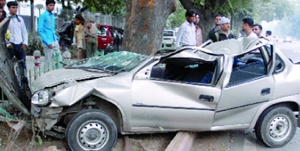
New Delhi: Jul 21: A pilot project of a scheme to provide cashless treatment for those injured in road accidents will be launched on the busy Delhi-Gurgaon-Jaipur national highway on July 29.
The Centre selected the 225-km highway to launch the scheme as it is one of the most accident-prone stretches in the country, claiming about 250 lives annually.
The government will expand the scheme to other highways based on the results of the pilot project, Union Minister for Road Transport and Highways Oscar Fernandes told Deccan Herald here on Saturday.
The aim of the scheme is to provide medical help within six to seven minutes of an accident which is considered as crucial time. Ten ambulances will be stationed at different places on highways. Once an accident occurs on the highways, a team of volunteers will reach the spot and provide first aid to victims. A photograph of the accident will be taken and uploaded on the server that can be accessed by hospitals to ascertain the facts.
The ministry will take care of the victim for the first 48 hours, and will spend a maximum of Rs 30,000 in that period. If the total treatment cost exceeds the Rs-30,000 cap, patients have to bear the expenditure. After 48 hours, the victim will be treated at discounted rates, which have to be worked out with state governments.
Hospitals where victims are admitted will be allowed to charge only rates prescribed under the Central Government Health Scheme or those prescribed by AIIMS.
A single toll-free number for ambulance services and a call centre to attend to emergency calls will be part of the scheme. The National Highway Authority of India will put up signboards at every 100 metres of highways displaying emergency contact numbers and a unique reference number to identify the exact accident spot.
As per the statistics available with the ministry, 17 lives were lost in road accidents every hour in 2011 in the country, while, in 2010, the figure was 15. On a pan-India basis, 1.42 lakh people died in road accidents in 2011, which was an increase of over 7,000 from the figure of 2010.








Comments
Add new comment